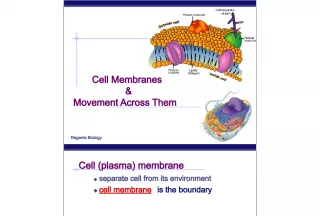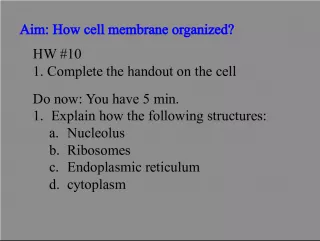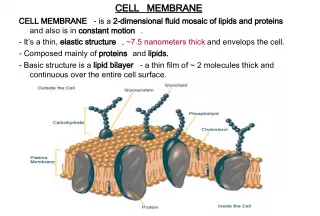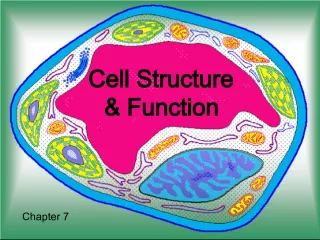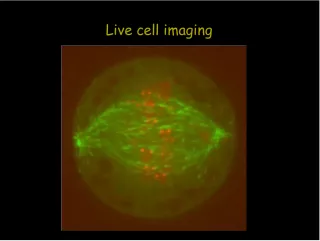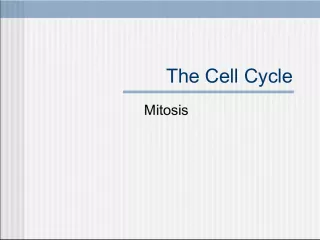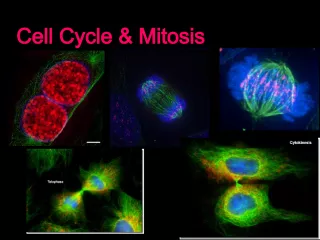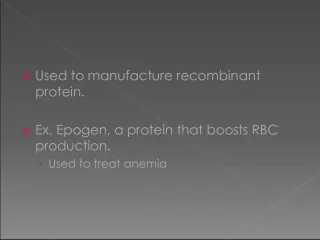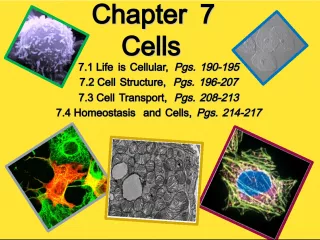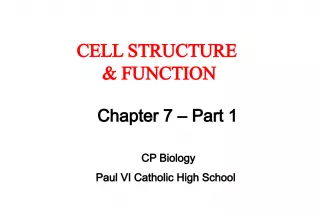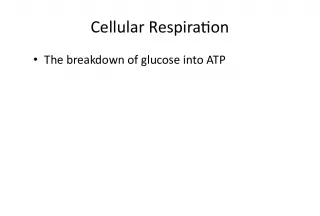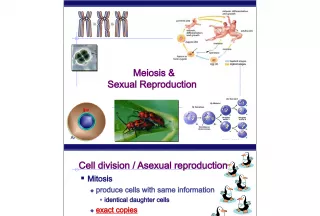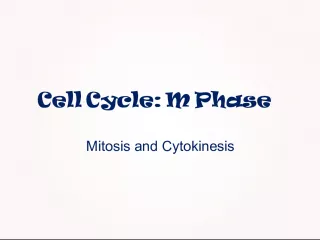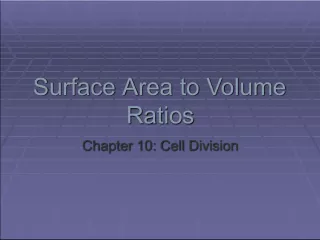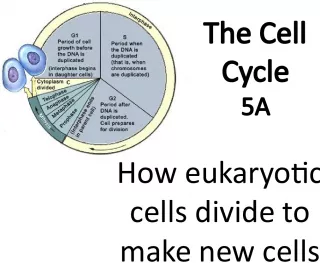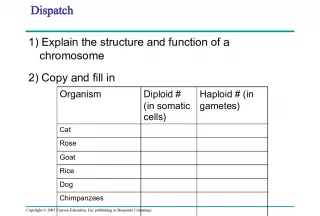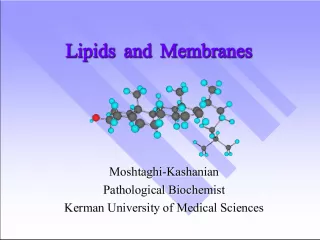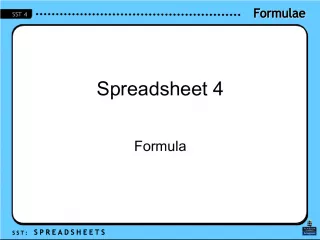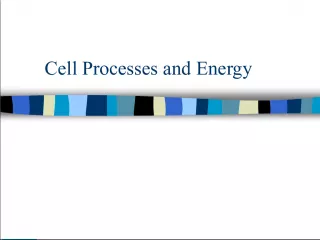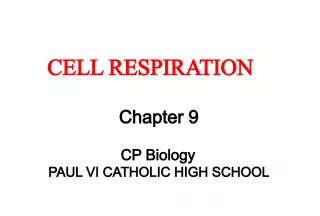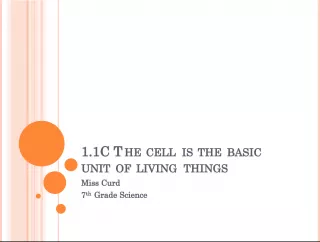Cell Boundaries: The Role of Cell Membrane and Cell Wall
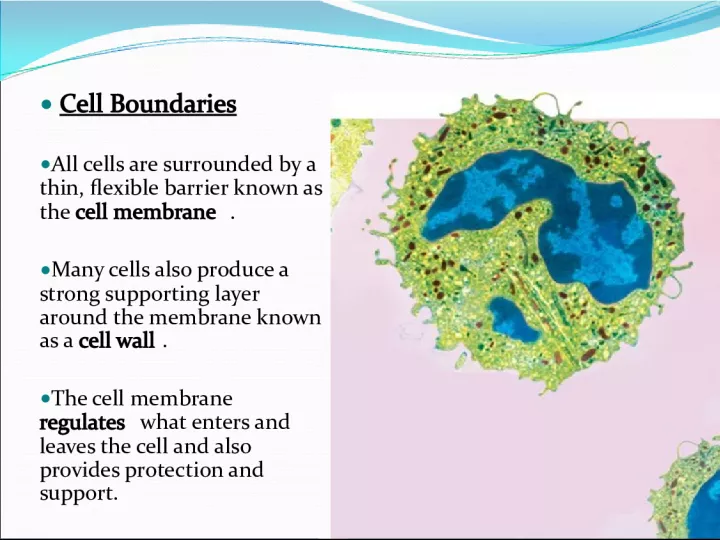

All living cells have a cell membrane, a thin flexible barrier that surrounds and protects the cell. Some cells also produce a strong supporting layer around the membrane called a
- Uploaded on | 3 Views
-
 dileep
dileep
About Cell Boundaries: The Role of Cell Membrane and Cell Wall
PowerPoint presentation about 'Cell Boundaries: The Role of Cell Membrane and Cell Wall'. This presentation describes the topic on All living cells have a cell membrane, a thin flexible barrier that surrounds and protects the cell. Some cells also produce a strong supporting layer around the membrane called a. The key topics included in this slideshow are . Download this presentation absolutely free.
Presentation Transcript
Slide1 Cell Boundaries All cells are surrounded by a thin, flexible barrier known as the cell membrane . Many cells also produce a strong supporting layer around the membrane known as a cell wall . The cell membrane regulates what enters and leaves the cell and also provides protection and support.
Slide2Cell MembraneCopyright Pearson Prentice Hall Outside of cell Cell membrane Inside of cell (cytoplasm) Protein channel Proteins Lipid bilayer Carbohydrate chains
Slide3Cell Membrane The composition of nearly all cell membranes is a double-layered sheet called a lipid bilayer . Copyright Pearson Prentice Hall Lipid bilayer
Slide4Cell Membrane Most cell membranes contain protein molecules embedded in the lipid bilayer, some of which have carbohydrate molecules attached to them. Copyright Pearson Prentice Hall Protein channel Proteins Carbohydrate chains
Slide5Cell Walls The main function of the cell wall is to provide support and protection for the cell. Copyright Pearson Prentice Hall
Slide6Cell Walls The main function of the cell wall is to provide support and protection for the cell. Cell walls are found in plants, algae, fungi, and many prokaryotes. The cell wall lies outside the cell membrane. Most cell walls are porous enough to allow water, oxygen, carbon dioxide, and certain other substances to pass through easily. Copyright Pearson Prentice Hall
Slide7Diffusion Through Cell Boundaries Every living cell exists in a liquid environment. The cell membrane regulates movement of dissolved molecules from the liquid on one side of the membrane to the liquid on the other side. Bouncy egg Video 2 Measuring Concentration A solution is a mixture of two or more substances. The substances dissolved in the solution are called solutes. The concentration of a solution is the mass of solute in a given volume of solution, or mass/volume . Copyright Pearson Prentice Hall
Slide8Diffusion Through Cell Boundaries Particles in a solution tend to move from an area where they are more concentrated to an area where they are less concentrated . When the concentration of the solute is the same throughout a system, the system has reached equilibrium . Copyright Pearson Prentice Hall
Slide9Diffusion Through Cell BoundariesCopyright Pearson Prentice Hall
Slide10Copyright Pearson Prentice HallThere is a higher concentration of solute on one side of the membrane as compared to the other side of the membrane.
Slide11Copyright Pearson Prentice HallSolute particles move from the side of the membrane with a higher concentration of solute to the side of the membrane with a lower concentration of solute. The solute particles will continue to diffuse across the membrane until equilibrium is reached.
Slide12Copyright Pearson Prentice HallWhen equilibrium is reached, solute particles continue to diffuse across the membrane in both directions.
Slide13Diffusion Through Cell Boundaries Diffusion depends upon random particle movements. Therefore, substances diffuse across membranes without requiring the cell to use energy. Copyright Pearson Prentice Hall
Slide14Osmosis T he diffusion of water through a selectively permeable membrane. Osmosis video 1 Copyright Pearson Prentice Hall
Slide15Osmosis How Osmosis Works Copyright Pearson Prentice Hall Movement of water Dilute sugar solution (Water more concentrated) Concentrated sugar solution (Water less concentrated) Sugar molecules Selectively permeable membrane
Slide16Osmosis Water tends to diffuse from a highly concentrated region to a less concentrated region. If you compare two solutions, the more concentrated solution is hypertonic (“above strength”). The more dilute solution is hypotonic (“below strength”). When concentrations of solutions are the same on both sides of a membrane, the solutions are isotonic (”same strength”). Copyright Pearson Prentice Hall
Slide17Osmosis Osmotic Pressure Osmosis exerts a pressure known as osmotic pressure on the hypertonic side of a selectively permeable membrane. Water tends to diffuse from a highly concentrated region to a less concentrated region. If you compare two solutions, the more concentrated solution is hypertonic (“above strength”). Copyright Pearson Prentice Hall
Slide18Osmosis Because the cell is filled with salts, sugars, proteins, and other molecules, it will almost always be hypertonic to fresh water. If so, the osmotic pressure should produce a net movement of water into the cell. As a result, the volume of the cell will increase until the cell becomes swollen or bursts. Copyright Pearson Prentice Hall
Slide19Osmosis Cells in large organisms are not in danger of bursting because they are bathed in fluids, such as blood, that are isotonic . Other cells are surrounded by tough cell walls that prevent the cells from expanding even under tremendous osmotic pressure. Video 1 * *Excellent Copyright Pearson Prentice Hall
Slide20Facilitated Diffusion Cell membranes have protein channels that act as carriers, making it easy for certain molecules to cross. Carrier Proteins – change shape & transport ions or very small molecules Copyright Pearson Prentice Hall
Slide21Facilitated Diffusion Cell membranes have protein channels that act as carriers, making it easy for certain molecules to cross. Carrier Proteins – change shape & transport ions or very small molecules Copyright Pearson Prentice Hall Protein channel Glucose molecules
Slide22Active transport requires energy which is provided by the cell via Adenosine Triphosphate (ATP). Video 1 Copyright Pearson Prentice Hall Molecule to be carried
Slide23Active Transport Endocytosis and Exocytosis Material undergo active transport in or out of a cell membrane. Endocytosis is the process of taking material into the cell by means of infoldings, or pockets, of the cell membrane. Two example: phagocytosis and pinocytosis Exocytosis releasing of large amounts of material from the cell. the membrane of the vacuole surrounds the material fuses with the cell membrane, forcing the contents out of the cell. Video 1 Copyright Pearson Prentice Hall
Slide24Sodium-Potassium Pump Six Steps! BTW: This pump creates a movement of ions across the membrane thus creating an electric charge = nerve signal. 1. 3 Na+ ions bind to the inside of the membrane 2. Energy is used to change the shape of the carrier protein. 3. 3 Na+ ions forced to the outside. (Against their willlll!) Repeat in reverse with K+ 4. 2 K+ inons attach to the outside of the cell membrane’s carrier protein. 5. Energy is used to change shape of the carrier protein. 6. 2 K+ ions are forced into the cell. McGraw Hill Video
Slide25Unlike a cell wall, a cell membrane: A. is composed of a lipid bilayer. B. provides rigid support for the surrounding cell. C. allows most small molecules and ions to pass through easily. D. is found only in plants, fungi, algae, and many prokaryotes . Copyright Pearson Prentice Hall
Slide26The concentration of a solution is defined as the: A. volume of solute in a given mass of solution. B. mass of solute in a given volume of solution. C. mass of solution in a given volume of solute. D. volume of solution in a given mass of solute. Copyright Pearson Prentice Hall
Slide27If a substance is more highly concentrated outside the cell than inside the cell and the substance can move through the cell membrane, the substance will: A. move by diffusion from inside the cell to outside. B. remain in high concentration outside the cell. C. move by diffusion from outside to inside the cells D. cause water to enter the cell by osmosis. Copyright Pearson Prentice Hall
Slide28The movement of materials in a cell against a concentration difference is called: A. facilitated diffusion. B. active transport. C. osmosis. D. diffusion. Copyright Pearson Prentice Hall
Slide29The process by which molecules diffuse across a membrane through protein channels is called: A. active transport. B. endocytosis. C. facilitated diffusion. D. osmosis. Copyright Pearson Prentice Hall
